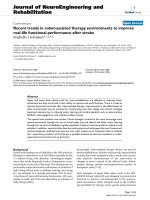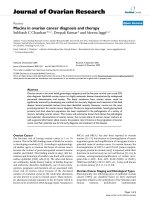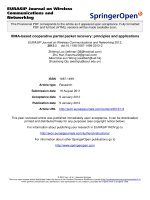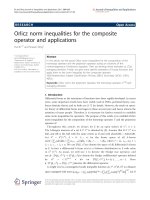RECENT TRENDS IN CYTOGENETIC STUDIES – METHODOLOGIES AND APPLICATIONS ppt
Bạn đang xem bản rút gọn của tài liệu. Xem và tải ngay bản đầy đủ của tài liệu tại đây (22.54 MB, 156 trang )
RECENT TRENDS IN
CYTOGENETIC STUDIES –
METHODOLOGIES AND
APPLICATIONS
Edited by Padma Tirunilai
Recent Trends in Cytogenetic Studies – Methodologies and Applications
Edited by Padma Tirunilai
Published by InTech
Janeza Trdine 9, 51000 Rijeka, Croatia
Copyright © 2012 InTech
All chapters are Open Access distributed under the Creative Commons Attribution 3.0
license, which allows users to download, copy and build upon published articles even for
commercial purposes, as long as the author and publisher are properly credited, which
ensures maximum dissemination and a wider impact of our publications. After this work
has been published by InTech, authors have the right to republish it, in whole or part, in
any publication of which they are the author, and to make other personal use of the
work. Any republication, referencing or personal use of the work must explicitly identify
the original source.
As for readers, this license allows users to download, copy and build upon published
chapters even for commercial purposes, as long as the author and publisher are properly
credited, which ensures maximum dissemination and a wider impact of our publications.
Notice
Statements and opinions expressed in the chapters are these of the individual contributors
and not necessarily those of the editors or publisher. No responsibility is accepted for the
accuracy of information contained in the published chapters. The publisher assumes no
responsibility for any damage or injury to persons or property arising out of the use of any
materials, instructions, methods or ideas contained in the book.
Publishing Process Manager Vana Persen
Technical Editor Teodora Smiljanic
Cover Designer InTech Design Team
First published February, 2012
Printed in Croatia
A free online edition of this book is available at www.intechopen.com
Additional hard copies can be obtained from
Recent Trends in Cytogenetic Studies – Methodologies and Applications,
Edited by Padma Tirunilai
p. cm.
ISBN 978-953-51-0178-9
Contents
Preface VII
Chapter 1 Cytogenetic Analysis of Primary Cultures and
Cell Lines: Generalities, Applications and Protocols 1
Sandra Milena Rondón Lagos and Nelson Enrique Rangel Jiménez
Chapter 2 Microtechnologies Enable Cytogenetics 25
Dorota Kwasny, Indumathi Vedarethinam,
Pranjul Shah, Maria Dimaki and Winnie E. Svendsen
Chapter 3 Array CGH in Fetal Medicine Diagnosis 41
Ricardo Barini, Isabela Nelly Machado
and Juliana Karina R. Heinrich
Chapter 4 Cytogenetics in Hematooncology 57
Ewa Mały, Jerzy Nowak
and Danuta Januszkiewicz-Lewandowska
Chapter 5 Genetic Studies in Acute
Lymphoblastic Leukemia, from
Diagnosis to Optimal Patient’s Treatment 71
Małgorzata Krawczyk-Kuliś
Chapter 6 Cytogenetic Instabilities in Atomic
Bomb-Related Acute Myelocytic
Leukemia Cells and in Hematopoietic
Cells from Healthy Atomic Bomb Survivors 93
Kimio Tanaka
Chapter 7 Cytogenetic Analysis:
A New Era of Procedures and Precision 107
Diones Krinski, Anderson Fernandes and Marla Piumbini Rocha
Chapter 8 Chromosomes as Tools for Discovering
Biodiversity – The Case of Erythrinidae Fish Family 125
Marcelo de Bello Cioffi, Wagner Franco Molina,
Roberto Ferreira Artoni and Luiz Antonio Carlos Bertollo
Preface
Cytogenetics - the study of chromosomes as hereditary units has been an active field of
research for over a century, contributing to the understanding of organization of
chromosomes, of genetic and non-genetic components they are comprised of and
knowing ultimately the entire organization of genome of a given species. At the turn
of the last century, the merger of the two fields - cytology describing the cell structure,
function and division and genetics that governs the inheritance of traits through
generations, resulted as a new field “Cytogenetics” that has progressed tremendously
with an outcome of multiple applications like identification of a species and its
evolution based on the chromosome number, their structural and numerical
variations; role of chromosomal aberrations in the etiology of birth defects, syndromes
and malignant tissues. To-day clinical evaluation of several conditions and their
therapeutic interventions are based on detailed cytogenetic analysis carried out at
micro level using advanced technologies that came into vogue with the passing time.
The first foundation to this very important field of clinical cytogenetics was laid in the
year 1956 when Tjio and Levan established the chromosome number in humans as 46
ruling out the much believed number of 48 that was also found in great apes. The
number was interpreted to have reduced to 46 because of the formation of
chromosome 2 due to merger with ancestral chromosome. The preparation of human
karyotype for the first time in 1959 led to the identification of numerical aberrations in
the following years associated with Down’s, Turner and Klinefelter syndromes which
implied the need for routine screening for chromosomal anomalies in certain clinical
conditions. At the same time structural defects like deletion of chromosome 21
referred as Philadelphia chromosome that was found consistently in patients of
chronic myelogenous leukemia opened up new approach of screening for
chromosomal variations such as deletions, duplications and translocations in patients
with different types of tumors. Further development of banding techniques and study
of prometaphase chromosomes facilitated better identification of these variations with
high resolution. Culturing of free amniocytes was another breakthrough that allowed
the identification of chromosomal abnormalities associated with birth defects. These
classical cytogenetic techniques became mandatory for several clinical conditions and
were adopted by many laboratories as a routine. Later with the adoption of molecular
biology techniques especially the hybridisation technique, the field of cytogenetics
transformed itself into the field of “molecular cytogenetics”. Discovery of DNA probes
and their tagging with fluorescent dyes evolved a new technique called “Fluoroscent
VIII Preface
labeled in situ Hybridisation” (FISH) that enables chromosomal analysis at various
levels including direct allocation of DNA regions to specific chromosomal sites,
detection of gain or loss of interstitial chromosomal regions such as microdeletions,
duplications and several structural variations that cannot be traced by the application
of age old classical techniques. Other significant contributions of FISH include study of
interphase nuclei, cultured specimens and cells from specimens embeded in paraffin.
In spite of these advancements, heterogeneous chromosomal changes occurring in
cancer cells make the interpretation of the observations more complicated and
challenging. Thus the determination of overall genomic changes occurring in a given
tissue affected with cancer growth became the need of the hour. As a consequence two
types of “Comparative genomic hybridisation” (CGH) techniques referred as
metaphase CGH and array based CGH emerged enabling the identification of “Copy
number variations” (CNV) in the genome with cells showing abnormal number of
copies of DNA sections i.e either deletions or duplications. These CNVs may show
association with certain clinical conditions and help in predicting risk and also
diagnosis. All these approaches have their merits and demerits and in general are
tedious, time consuming and need manpower with stringent handling. This naturally
prompted the development of several automated methods for culturing cells in mass
scale, use of membrane bioreactors, and image analysis for interpreting the cytogenetic
observations made. It has now become imminent to screen and detect abnormalities
with optimal precision to aid the therapeutic interventions and treatment of clinical
conditions especially the malignant tumors. The technologies that are expensive now
are expected to become more cost effective and affordable in due course.
This book covers various aspects related to recent trends in cytogenetics with minute
details of methodologies that can be adopted in clinical laboratories. The focus is on
the basic methods of primary cultures, cell lines and their applications;
microtechnologies and automations; array CGH for the diagnosis of fetal conditions;
various cytogenetic approaches to deal with acute lymphoblastic and myeloblastic
leukemias in patients and survivors of atomic bomb exposure. Use of digital image
technology in analyzing cytogenetic changes is emphasized taking sting less bees from
Brazil as a model organism. Use of chromosomes as tools to discover biodiversity is
also discussed quoting the example of Erythrinidae fish family. While concentrating
on the advanced methodologies in cytogenetic studies along with their applications,
the authors have pointed out the need to develop the cytogenetic labs with modern
tools and approaches to make precise and effective decisions to benefit the patient
population.
Dr. Padma Tirunilai
Retd. Professor, Department of Genetics,
Osmania Univertsity, Hyderabad
India
1
Cytogenetic Analysis of
Primary Cultures and Cell Lines:
Generalities, Applications and Protocols
Sandra Milena Rondón Lagos
1
and Nelson Enrique Rangel Jiménez
2
1
Doctoral Program in Biomedical Sciences, Universidad Del Rosario
2
Azienda Ospedaliero-Universitaria S. Giovani Battista di Torino
1
Colombia
2
Italy
1. Introduction
Cytogenetics constitutes an important diagnostic tool to determine and/or confirm specific
syndromes nowadays; its use is directed towards the selection of treatments and monitoring
of patients using different procedures. These latter are carried out in order to obtain a
karyotype from peripheral blood or several tissue biopsies (e.g. biopsies from patients with
melanoma, breast cancer, skin biopsies, foreskin samples, abortion products, among others).
However, the study of chromosomal abnormalities in culture cells has been limited by
complex processes such as achieving cell growth and a good number of metaphases, which
in turn hampers the chance to obtain a useful number of metaphase spreads in order to
carry out a proper cytogenetic analysis, that should be able to display a good morphology,
an adequate dispersion and a correct banding. Cell lines are widely used in different
research fields, particularly in invitro models for cancer research. (Burdall et al., 2003)
Given the importance of the model used to examine and manipulate potentially relevant
molecular and cellular processes underlying malignant diseases, it is necessary to achieve an
accurate and comprehensive karyotyping for cultures of different cell lines. In turn,
karyotyping provides an insight into the molecular mechanisms leading to cellular
transformation and could allow clarifying possible cytogenetic aberrations associated to
drugs exposure and the development and progression of different types of cancer. The fast
increase observed in cancer incidence is forcing us to carry out more identification studies of
cytogenetic biomarkers associated to development of this disease, which could contribute
for a better understanding of the carcinogenic process and could also have enormous
implications for the development of effective anticancer therapies.
Obtaining metaphase cells for chromosome analysis requires the use of a series of reagents,
protocols, and environmental conditions, among others, that will allow us to collect the
chromosomes. Metaphase cells must be cultured under certain conditions in order to obtain
a proper number of dividing cells, which need to grow and divide fast in this medium as
well. Taking into account all the issues mentioned above, an accurate knowledge from the
culture medium and its conditions, as well as the techniques and protocols required in
Recent Trends in Cytogenetic Studies – Methodologies and Applications
2
general, will allow a good cell growth in the culture and the collection of chromosome
spreads to carry out the cytogenetic characterization and the identification of chromosomal
abnormalities present in the cells in study.
This chapter describes the practical aspects of performing cytogenetic studies in primary
cultures and human cancer cell lines that have been previously standardized, in order to be
applied not only in research but in diagnosis and possible treatment of several diseases.
2. Generalities
The application of cytogenetic studies on tissue and cancer cell lines has become important
in recent years, because the presence of some chromosomal abnormalities indicate the
prognosis of the disease and the corresponding response to therapy. The most common
clinical applications of cytogenetic studies on tissue and cancer cell lines are:
Establishing the type of chromosomal abnormalities and its frequency
Identifying the genes located in the affected chromosomal regions in order to establish
those possibly implied in neoplasia
Studying tumorigenic and metastatic behaviors, apoptosis and functionality
Identifying the mechanisms of action used by hormones
Establishing models for drug resistance studies
Establishing the therapeutic potential of different treatments
Supporting further research.
The knowledge of novel chromosome rearrangements and breakpoints identified could be
useful for further molecular, genetic and epigenetic studies on human cancer that could lead us
to understand the mechanisms involved in the development and progression of this disease.
2.1 Characteristics of cell cultures
Cell cultures can be divided into two groups, depending on the substrate used for cell growth:
Suspension cultures: Cells are cultured by constant agitation in a liquid medium. Cell
cultures are prepared by diluting cell suspensions.
Monolayer cultures: Cells adhere to a solid (glass or plastic) or semisolid (agar, blood
clot) surface, forming a cell surface, which can be observed by light microscopy or
phase contrast. Cultures are maintained by releasing cells from the substrate using
mechanical or enzymatic procedures, continuing their life cycle in new cell subcultures.
2.1.1 Requirement of cell growth
There are several variables that determine whether a cell will multiply in vitro or not, some
of these depend directly on the conditions of the growth medium and some do not.
The growth medium must possess all the essential, quantitatively balanced nutrients. It
must include all the necessary raw material to promote the synthesis of cellular
macromolecules; it must also provide the substrate for metabolism (energy), vitamins
and trace minerals (their primary function is catabolic) and a number of inorganic ions
implied in the metabolic function.
Cytogenetic Analysis of Primary Cultures and
Cell Lines: Generalities, Applications and Protocols
3
Physiological parameters: temperature, pH, osmolarity, redox potential, which must be
kept within acceptable limits.
Cell density and subculture mode
Serum is added to the basal medium to stimulate cell multiplication and interaction
with the other variables contained in the system. It serves as a source of
macromolecular growth factors. Serum is a very effective supplement that promotes cell
division because it contains different growth-promoting factors. Complete serum
contains most of low molecular weight nutrients required for cell proliferation. Serum
may neutralize trypsin and other proteases, provide a protein "carrier" to solubilize
water-insoluble substances (such as lipids) and has the ability to provide hormones and
growth factors to cells.
2.1.2 Contamination of cell cultures
Cell cultures can be contaminated by fungi, bacteria, mycoplasma, viruses, parasites or cells
from other tissues. It is mistakenly thought that tissues obtained using aseptic techniques
from apparently healthy animals are sterile; however, it is common to find bacteria,
mycoplasma, viruses or other microorganisms in these tissues. Fungi and bacteria are
universally distributed in nature and are relatively resistant to environmental factors such
as temperature, radiation, and desiccation, among others.
These organisms can appear in cultures due to several factors:
Through dust particles carried by air currents.
Aerosols produced by the operator during handling.
Through non-sterile equipment.
Viruses and mycoplasmas are found in nature mainly in cells and body fluids, and these are
more sensitive than fungi and bacteria to environmental factors. The most important sources
of contamination with mycoplasma are aerosols and sera used in culture mediums. Other
routes of entry for the virus are other infected cell cultures, serum or spray. Three factors are
determining the effectiveness of a sterility test:
Sensitivity and spectrum of the medium used.
Incubation terms and time.
Sample Size
The medium used for these tests should be sensitive and have a broad spectrum to detect
anaerobic bacteria, fungi and mycoplasmas in routine testing. Cultures for bacteria and
mycoplasma should be incubated aerobically and anaerobically, in order to avoid the loss of
detection of some microorganisms. It is recommended to test for sterility at different times
in the initiation and harvesting of the cell culture (beginning, middle and end).
2.1.3 Contamination of cell cultures by other cells
A very common contamination, generally not considered by researchers working in cell
culture, is cross-contamination between cell cultures, both at the intra and interspecific level
(MacLeod et al., 1999; Marcovic & Marcovic 1998; Masters et al., 2001; van Bokhoven et al.,
2001; Masters 2002). Several cases of cross-contamination between cell cultures have been
Recent Trends in Cytogenetic Studies – Methodologies and Applications
4
documented in the last years, this has been possible by some sources that are able to provide
certified cell lines, which can be used when contamination in the cell culture is suspected.
Approximately, a 20 to 30% of cell cultures are contaminated at the intra or interspecific
level, and it is believed that this value is higher due to the large number of contaminated
cultures, on which there is no suspicion. The most convenient way to avoid contamination is
to use rigid sterilization and aseptic techniques, the culture medium must be proven for
contamination before use, working with cell cultures in laminar flow chambers,
decontaminate the work area on a daily basis and furthermore, when there is manipulation
of different cell lines.
2.2 Human cancer cell lines
Many human carcinoma cell lines have been developed and are widely used for laboratory
research, mainly in studies of tumorigenic and metastatic behaviors, apoptosis,
functionality, and therapeutic potential, and particularly as in vitro models for cancer
research. Among these cell lines are the following: MCF-7, SKBR3, TD47 and BT474.
2.2.1 Characteristics
MCF-7 is a cultured cell line from human breast cancer, which is widely used for studies on
breast cancer biology and hormones’ mechanism of action research. The cell line was
originally derived at the Michigan Cancer Foundation from a malignant pleural effusion
found in a postmenopausal woman with metastatic breast cancer. The cells express
receptors as biological responses to a variety of hormones including estrogen, androgen,
progesterone, glucocorticoids, insulin, epidermal growth factor, insulin-like growth factor,
prolactin, and thyroid hormone with non-amplified HER2 status (Osborne et al., 1987)
The cell line SKBR3 is a highly rearranged, near triploid cell line, derived by Fogh and
Trempe (1975) from a pleural effusion and overexpresses the HER2/c-erb-2 gene
product. This cell line shows only a weak ESR2 (ERß) expression and no ESR1 (absence of
functional ERα) and PGR expression, indicating that this cell line represents models of
estrogen- and progesterone-independent cancers, with capability for local E2 formation and
possible action via non-ER mediated pathways. ERß expression level in tumor cell lines is
characterized by a significantly slowed proliferation (Hevir et al., 2011). ERß may negatively
regulate cellular proliferation, promote apoptosis and thus may have not only a protective
role in hormone-dependent tissues, such as breast and prostate, but also a tumor-suppressor
function in hormone-dependent tissues (Lattrich et al., 2008).
Human breast ductal carcinoma BT474 cell line was isolated by Lasfargues et al (1978). It
was obtained from a solid, invasive ductal breast carcinoma from a 60-year-old woman; cells
were reported as tumorigenic in athymic mice and were found to be susceptible for mouse
mammary tumor virus, confirmed as human with IEF from AST, GPDH, LDH and NP
(Lasfargues et al., 1979).
T47D is a cell line derived from human ductal breast epithelial tumor, it was isolated from a
pleural effusion obtained from a 54 year old female patient with an infiltrating ductal breast
carcinoma (Keydar et al., 1979). These cells contain receptors for a variety of steroids and
calcitonin. They express mutant tumor suppressor protein p53 protein. Under normal
culturing conditions, these cells express progesterone receptor constitutively and are
Cytogenetic Analysis of Primary Cultures and
Cell Lines: Generalities, Applications and Protocols
5
responsive to estrogen. They are able to lose the estrogen receptor (ER) during long-term
estrogen deprivation in vitro. Culture conditions, receptor status, patient age and source and
tumor type for each cell line are shown in Table 1 and Figure 1.
Cell
line
Source
code
Passage
no
Receptor
status
HER-2
status
Tissue
source
Tumor
type
Patient
age
Culture
conditions
T47D
ATCC:
HTB-133
P20
ER+
Negative PE IDC 54
RPMI 1640 + 10%
FBS + 2 mM L-
glutamine
+antibiotic-
antimycotic
solution (1X)
PR+
MCF-7
ATCC:
HTB-22
P16
ER+
Negative PE AC 69
PR+
SKBR3
ATTC:
HTB-30
P15
ER−
Positive PE AC 43
PR−
BT474
ATTC:
HTB-20
P12
ER+
PR+
Positive IDC IDC 60
DMEM + 10%
FBS + 2 mM
glutamine +
antibiotic-
antimycotic
solution (1X)
Table 1. Characteristics of the breast cancer cell lines AC, adenocarcinoma; IDC, invasive
ductal carcinoma; PE, pleural effusion; P, passage number. Media conditions: FBS, fetal
bovine serum; DMEM, Dulbecco’s Modified Eagle’s Medium. Cell lines were maintained at
37ºC and 5% CO2 in the indicated media
2.2.2 Cytogenetic abnormalities found in human cancer cell lines
MCF-7 cell line has a modal number from 82 to 86 with 56 types of aberrations: 28 numerical
and 28 structural aberrations. The most common aberrations in MCF-7 cells are der (19) t
(12;19)(q13;q13.3) and add(19)(p13) (Figure 2A).
SKBR3 cell line has a modal number from 71 to 83, with 48 types of rearrangements: 27
numerical and 21 structural rearrangements. The most common aberrations in this cell line
are del(1)(1p13) and add(17)(17q25) (Figure 2B).
BT474 cell line demonstrated to have a modal number from 65 to 106, with 67 different
rearrangements: 35 numerical and 32 structural aberrations. The most common aberrations
in this cell line are: Additional material of unknown origin on chromosome 14: add(14)(q31),
derivatives from chromosomes 6: der(6)t(6;7)(q25;q31) and 11: der(11)t(8;11;?)(q21.1;p15;?),
losses in chromosomes 15, 22 and X chromosome and a gain on chromosome 7 (Figure 2C).
T47D cell line have a modal number of 57 to 66, with 52 types of rearrangements: 26
numerical and 26 structural. The most common aberrations in this cell line are:
der(X)t(6;X)(q12;p11); der(8;14)(q10;q10); del(10)(p11.2); der(16)t(1;16)(q12;q12)
dup(1)(q21q43) and der(20)t(10;20(q21;q13.3) Figure 2D. The cell lines SKBR3 and BT474
exhibited amplification of HER-2 gen by FISH and the cell lines MCF-7 and T47D not have
amplification for this gene.
Recent Trends in Cytogenetic Studies – Methodologies and Applications
6
Fig. 1. Inverted microscopic pictures of representative breast cancer cell lines in a monolayer
culture. A) MCF-7; B) SKBR3; C) BT474; D) T47D
3. Cytogenetic techniques from tumoral tissue samples and cancer cell lines
Obtaining metaphase cells for chromosome analysis requires the use of a series of reagents
that will allow us to collect the chromosomes. Metaphase cells must be grown in vitro under
certain conditions in order to obtain a proper number of dividing cells. Cells used for
chromosome collection must be able to grow and divide fast in the culture medium.
Different types of cells may require specific growth factors and medium supplements; once
the basic requirements for each cell type are known, the appropriate culture medium is
selected, checking sterility appropriately. After the culture has reached the 80% of
confluence, it must be harvested and fixed to make a cytogenetic suspension. Cultures are
growth arrested and accumulated in metaphase or prometaphase by inhibiting tubulin
polymerization and thus preventing the formation of the mitotic spindle (e.g., using
colcemid or velbe). Following exposure to colcemid or velbe, cells are treated with a
hypotonic solution to enhance the dispersion of chromosomes and fixed with carnoy fixative
(Methanol: Acetic Acid). Once fixed, the cytogenetic preparation can be stored in cell pellets,
under fixative conditions and 20ºC for several months. Fixed cells are spread on slides and
air-dried, to be finally banded for the correct identification of chromosomes. Obtaining an
Cytogenetic Analysis of Primary Cultures and
Cell Lines: Generalities, Applications and Protocols
7
Fig. 2. Karyotypes from breast cancer cell lines. A) MCF-7; B) SKBR3; C) BT474; D) T47D15-
ml conical centrifuge tube
adequate quality on chromosome spreads is multifactorial; this will be discussed in detail
further on. The amount of metaphases obtained is sometimes inadequate for chromosome
analysis, thus it is always necessary to keep growing the cell line.
3.1 Materials, reagents and equipment
3.1.1 Equipment
Laminar flow chamber
Incubator
CO2 Incubator
Serological bath
Centrifuge
Refrigerador
Microscope with camera
Inverted microscope
Magnetic Stirrer
Micropipettes
Analytical balance
Vacuum Pump
Recent Trends in Cytogenetic Studies – Methodologies and Applications
8
3.1.2 Materials
75-cm
2
tissue culture flasks
25-cm
2
tissue culture flasks
Sterile disposable plastic transfer pipettes
Glass slides
Coverslip sheets
Petri dishes
3.1.3 Reagents
Solutions should be kept in the dark at -20ºC or 4°C, according to the manufacturer's
instructions. According to frequency of use, reagents should be aliquoted and frozen.
Reagents should be thawed before use and stored at 4°C. Frequent freezing and unfreezing
may cause alteration of the culture medium by inactivating the components.
Medium: The most commonly used medium for cell cultures are Dulbecco’s modified
Eagle’s medium-DMEM, RPMI 1640 and DMEM-F12, among others. If the medium does not
contain Glutamine, L-glutamine should be added (final concentration 2mM); this is an
essential amino acid that is unstable and has a short life at room temperature. To each 500
ml bottle of medium, add 50 ml of Fetal Bovine Serum, 5 ml of L-Glutamine (200 mM) and 5
ml of antibiotic-antimycotic solution (100x). Store the medium up for a month at 4ºC. In
order to establish primary cultures it is recommended to add also hydrocortisone, estradiol
and insulin to the culture medium, providing enough nutrients to induce cell growth.
Serum: Fetal bovine serum; the proportion commonly added is 50ml of serum per each 450
ml of medium. Usually, the presentation of fetal bovine serum is 500 ml, so this amount
should be aliquoted in 50 ml aliquots which must be stored at -20ºC and thawed at 4ºC or
room temperature prior to use. It is advisable not to thaw the medium at high temperatures
(37°C or more), as this could alter its composition.
Collagenase stock solution: Type 2 collagenase. To make the stock solution, dissolve 215
U/mg collagenase in distilled water to obtain a final concentration of 2000 U/ml, filter the
solution through a 0.2-μm filter and prepare 1 ml aliquots, these can be kept stored for 2–3
months at –20°C. The working solution of 200 U/ml is prepared immediately before use,
adding 1 ml collagenase each 9 ml of complete medium. This solution should be kept at 4ºC.
Arresting agents:
Colcemid: Colchicine inhibits microtubule assembly by binding to a high affinity site on -
tubulin. Colchicine binding occurs in a nearly irreversible manner and exerts a
conformational change in tubulin, as well as in colchicine itself. (Daly, et al. 2009). Colcemid
is used on cell lines displaying a high-speed replication and is applied to a final
concentration of 0,01 g/ml for 2.5 hours.
Velbe: Described as a vinca alkaloid, also called vinblastine, this agent is derived from the
periwinkle plant, Catharanthus roseus, and is noted as the most successful anticancer agent
within the past few years. Binding of the vinca alkaloids to -tubulin occurs fast and reversibly
at an intermolecular contact point (Daly, 2009). It is recommended to use Velbe if the rate of
cell replication is low at a final concentration of 0,01 g/ml in a maximum of 16 hours.
Cytogenetic Analysis of Primary Cultures and
Cell Lines: Generalities, Applications and Protocols
9
The application of these reagents can arrest cells in metaphase and helps chromosomes
contraction, allowing an easy recognition of these cells in pro-metaphase or metaphase. The
use, exposure time and Colcemid or Velbe concentration varies and depends on several
factors, including cell type and overall growth characteristics.
Hypotonic solution: Saline solution that allows chromosomes dispersion within the cell
membrane, facilitating its observation and recognition. In order to obtain chromosome
preparations from cell lines, the following hypotonic solutions can be used; the selection of
this solution will depend on the degree of chromosome condensation obtained.
0.075 M potassium chloride (KCl): Use 5.59 g KCl and make up to 1 liter of aqueous solution.
Use the solution at 37°C.
20 mM potassium chloride (KCl) and 10 mM sodium citrate (Na
3
C
6
H
5
O
7
): Use 1 g KCl and 1g
sodium citrate and make up to 500 ml of aqueous solution. Use the solution at 37°C. Its use
is recommended with longer chromosomes, that may be twisting or overlapping.
Fixative: Reagent used to stop the action of hypotonic solutions and which in turn, has
several functions throughout the procedure related to hemolysis, dehydration,
chromosomes fixation and removal of debris membrane that may interfere with the
chromosome extended. This reagent is prepared with three parts of absolute methanol and
one part of glacial acetic acid. This should be freshly prepared just before its use and should
be kept always cold (-20ºC).
10x Trypsin-EDTA: Stored frozen in 1 ml aliquots. Diluted 1:10 in PBS when required to
obtain a 1x working solution. Store indefinitely at 4ºC. Place at room temperature or 37ºC
before use.
Phosphate-buffered saline (PBS): pH 7, used for diluting solutions.
Stains:
Wright’s stain: This stain is usually obtained as a powder. Cover a flask with aluminum foil
and insert a magnetic stirrer. Add 0.5 g stain and 200 ml methanol. Stir for 30 min. Filter
using a filter paper into a foil-coated bottle. Close the lid tightly and store the bottle in a
dark cupboard for at least a week before its use. The stain should be diluted immediately
before use at 1:4 with pH 6.8 buffer.
Giemsa: This stain is usually obtained as a liquid. Before use, the following mixture must be
prepared: 0.2 ml Giemsa, 0.2 ml Sorensen Tampon and 4.6 ml water (the amount used to dye
a slide).
Saline-sodium citrate (SSC) buffer: This is a widely used weak buffer, which is used to
carry out several washes and to control stringency during in situ hybridization. The 20x
stock solution consists in mixing 3M sodium chloride and 300mM trisodium citrate. To
make the stock, dissolve 38,825 g sodium chloride (NaCl) and 22.05 g sodium citrate
(Na
3
C
6
H
5
O
7
.2H
2
O) in 200 ml of water. Adjust to pH 7 with NaOH or HCl if necessary, make
up to 250 ml and sterilize by autoclaving procedures.
Sorensen Buffer: This buffer is used for G-Banding. The working solution consists in two
solutions: KH
2
PO
4
and Na
2
HPO
4
. Prepare the buffer as follows:
Sln A: KH
2
PO
4
. Dissolve 4559 grs in 500 ml of sterile distilled water
Recent Trends in Cytogenetic Studies – Methodologies and Applications
10
Sln B: Na
2
HPO
4
. Dissolve 4755 grs in 500 ml of sterile distilled water.
Take 500 ml of solution A and mix it with 496.8 ml of solution B, keep it at 4°C.
HCl 0,2 N: Used for G-Banding. To prepare 1000 ml of solution, add 8,25 ml HCl 37% and
500 ml H
2
O into a glass container. Store at room temperature.
3.2 Cell culture methods from tumoral tissue
To ensure cell growth and obtain cells in metaphase, it is important to take into account
all the sampling conditions. Sterile, non-necrotic tumor samples must be collected in a
transport container using optimal conditions of sterility; for example, a sterile tube
containing sterile culture medium, an antimycotic and a double concentration of
antibiotics, which should be transported to laboratory facilities under controlled
temperature.
The tissue sample must be representative, sterile, and viable. To ensure fast cellular growth
and prevent contamination with other cell types, the cultures must be incubated in a small
culture flask (25cm
2
) or directly on microscopic slides mounted in multi-well chambers. Cell
attachment, proliferation, and mitotic rate should be monitored by daily x examination
through an inverted microscope.
The steps to obtain metaphases are:
3.2.1 Dissociation of solid specimen: Enzymatic and mechanical procedures
3.2.2 Culture initiation
3.2.3 Culture harvesting and metaphases
3.2.4 Banding techniques
3.2.5 Freezing of viable cells
The way of determining the time of harvest, colchicine use and exposure to hypotonic
solution will depend on the cell type and its growth rate.
3.2.1 Dissociation of solid specimen
Materials
Collagenase (2000 U/ml)
Appropriate culture medium (RPMI 1640, DMEM-F12) containing 10% fetal bovine
serum (FBS), antibiotic-antimycotic solution (1X), L-glutamine (2 mM), Hydrocortisone,
17-estradiol and insulin.
PBS (1X)
25-cm
2
tissue culture flasks
15-ml conical centrifuge tube
5-ml and 10-ml plastic pipettes
Petri dishes
Microscopic slides mounted in multi-well chambers x 6 wells
Tissue dissection equipment: tweezers, scissors
Procedure
Mechanical Disaggregation (Figure 3)
Cytogenetic Analysis of Primary Cultures and
Cell Lines: Generalities, Applications and Protocols
11
Fig. 3. Representative pictures of tissue cultures, indicating the steps for mechanical
dissociation of tissue
Remove the specimen from the transport container and place it immediately into petri
dishes, using 5 ml PBS containing antibiotic and antimycotic agents, in order to wash
the tissue.
Take the tissue and transfer it to another petri dish containing 2 ml of medium;
afterwards, remove fat, necrotic tissue and/or blood that may interfere with cell
growth.
Using scissors and tweezers, cut the tissue into fragments of 1–2 mm in size.
Transfer some of the fragments to a petri dish for enzymatic digestion.
Take the other fragments and distribute them into 25 cm
2
plastic flasks containing 3 ml
of culture medium or in microscopic slides mounted in multiwell chambers x 6 wells
containing 1 ml of medium, using glass Pasteur pipettes.
Place flasks on their sides in an incubator at 37ºC in 5% CO
2,
incubate for 2-3 days.
Recent Trends in Cytogenetic Studies – Methodologies and Applications
12
Enzymatic Digestion
Using the tissue fragments previously deposited in petri dishes for enzymatic digestion,
add 2-3 ml medium containing collagenase at a final concentration of 200 U/ml.
Incubate at 37°C in 5% CO2 for 16–24h (overnight), stirring occasionally.
The times used for enzymatic treatment depends on the type of tumor, but generally an overnight
incubation is enough. Check disaggregation process under the inverted microscope. A large number of
single cells and small clusters of cells may be observed floating at the end of this period.
After this time, inactivate the enzyme by adding 2 ml of fetal bovine serum (FBS),
applied directly to the sample, and transfer the cell suspension to a 15-ml conical
centrifuge tube
Centrifuge for 10 min at 1000 rpm, discard the supernatant.
Add fresh medium to the tube, mix the suspension by pipetting up and down and transfer
the cell suspension to a 25-cm
2
tissue culture flask or to a multiwell chambers x 6 wells
Incubate at 37°C in 5% CO2 to allow cells that were attached to the plastic base to grow
during the collagenase treatment.
3.2.2 Culture initiation
Materials
Appropriate culture medium (RPMI 1640, DMEM-F12) containing 10% fetal bovine
serum (FBS), antibiotic-antimycotic solution (1X), L-glutamine (2 mM), Hydrocortisone,
17-estradiol and insulin
PBS (1X)
5-ml and 10-ml plastic pipettes
Procedure
After an incubation period of 24 hours, monitor the cell cultures (both those who were
and were not disaggregated enzymatically). Examine the culture using phase-contrast
microscopy to assess the extent of tissue adhesion and cell growth.
In a laminar flow chamber and under strict conditions of asepsis and sterility, remove
the medium containing unattached cells and cellular debris from flasks using a glass
Pasteur pipette
Add gently 2 ml PBS to wash and remove fragments attached; afterwards, remove PBS.
Add 4-5 ml of the medium and incubate again.
Examine flasks and the multiwell chambers daily through an inverted microscope in order to establish
cell growth and mitotic activity. Once cell cultures reach the 80% of confluence, these can be
processed to obtain metaphases. Figure 4.
Note: The culture of both fragments (both those dispersed enzymatically and the cell suspension after
the enzyme digestion) will ensure cell growth, since in some cases cell growth obtained from cell
suspension is insufficient to obtain metaphases
3.2.3 Harvesting of culture and metaphases for chamber slides
In a chamber slide the cells are not removed from the growing surface, is important to
control cell confluence, this can not be greater than 80% before the addition of colchicine,
Cytogenetic Analysis of Primary Cultures and
Cell Lines: Generalities, Applications and Protocols
13
Fig. 4. Pictures of solid tumor in culture. (a, b) Cell growth observed around fragments that
were disaggregated only by mechanical procedures, after 6 days of culture (4x-10x). (c,d)
Cell growth obtained after enzymatic disaggregation, after 8 days of culture (4x-10x). A
good cell growth was observed in both cell cultures; hence, it is advisable to prepare cell
cultures using both methods: enzymatically disaggregated fragments and fragments that
were mechanically disaggregated only.
since greater confluence is difficult to obtain a good number of metaphases. Colcemid is
added to the culture at a final concentration of 0.01 g/ml for 3 hours.
Materials
20 mM potassium chloride (KCl) and 10 mM sodium citrate(Na
3
C
6
H
5
O
7
)
Fixative methanol–acetic acid (3:1)
Pasteur pipette
Procedure
Carefully remove the medium with a Pasteur pipet.
Recent Trends in Cytogenetic Studies – Methodologies and Applications
14
Add 2ml of prewarmed hypotonic solution (20 mM potassium chloride (KCl) and 10
mM sodium citrate(Na
3
C
6
H
5
O
7
)) slowly down the side of the chamber and put into
incubator at 37°C for 17 min.
Remove the cultures of the incubator and carefully add, around of the well, 1ml of cold
freshly prepared fixative methanol–acetic acid (3:1) for 10 minutes
Remove all fluid and add 2 ml of fresh cold fixative slowly down the side of the well for
20 minutes.
Remove the fixative and add new fixative as in the previous step, repeat this step once
more
Finally, slowly remove the microscopic slide of the multiwell plate and put it on a slide.
Air-dry the slides at room temperature. Check spreading under phase-contrast
microscope.
3.2.4 Harvesting procedures for flasks
This protocol will be considered later, in the description for the one used to obtain
chromosome preparations from cell lines, since the procedure is the same (Protocol 3.3.2).
3.2.5 Banding techniques
There are several possibilities for G-banding; we will refer here two of the ones widely used
for chromosome analysis. Its implementation depends on the laboratory conditions and
standardization. The difference between them is the use of a reagent that allows the
degradation of chromosomal proteins (trypsin or HCl) and the dye (Wright or Giemsa).
Protocol 1
Materials
0,2 N HCl
2xSSC Buffer, prewarmed at 65º in a water bath
Wright’s stain
Sorense Buffer Tampon
Disposal plastic pipettes
Coupling Glass
Procedure
Heat the slides in an oven at 70ºC for 24 hours
Remove the slides from the oven, leave for cooling and add 1-2 ml 0.2 N HCl on each
slide for 2 minutes, using a Pasteur pipette
Remove the HCl and thoroughly rinse with distilled water, let dry.
Place carefully the slides in 2xSSC buffer, preheated at 65ºC for 4 minutes.
Remove the plates from the buffer and wash thoroughly with distilled water, let dry.
The time in HCl and in buffer depends on the type of cell; these times have been standardized for
certain cell lines. If you do not get a good banding, you should standardize the time of exposure to
these reagents.
Dye the slides by adding 1-2 ml of Wright’s dye solution on each slide, for 3 minutes.
Cytogenetic Analysis of Primary Cultures and
Cell Lines: Generalities, Applications and Protocols
15
Wright’s stain solution is prepared by mixing 1 ml of Wright’s stain with 3 ml of Sorensen buffer;
this amount should be enough to dye 2 or 3 slides.
Remove the stain and wash thoroughly with distilled water.
View under a microscope to evaluate the banding quality.
Cover slides with coverslips and seal them with Entellan to protect and preserve the
chromosome spreads.
Protocol 2
Materials
Trypsin 0.25%
2xSSC Buffer, prewarmed at 60º in a water bath
Giemsa stain
Sorense Buffer tampon
Disposal plastic pipettes
Coupling Glass
Procedure
Dehydrate the slides in an oven at 80ºC for 4 hours
Remove the slides from the oven and carefully, place the slides in 2xSSC buffer
preheated at 60ºC for 30 minutes
Remove the slides from the buffer and wash thoroughly with distilled water, let dry.
Introduce the slides in the coupling glass containing a cold solution of trypsin with
water (1:1) for 5 seconds
The trypsin stock solution for G-banding is at a concentration of 0.25%. The working solution
consists of a 1:1 mixture with cold distilled water. This solution must be kept at 4°C, at this
temperature best results are obtained.
Remove the slides from trypsin and wash thoroughly with distilled water, let dry.
The time in trypsin depends on the type of cell; these times have been standardized for certain cell
lines. If you do not get a good banding, you should standardize the time of exposure to these reagents.
For best results, trypsin should always be kept cold and plates should remain hot. Once hot slides are
introduced into cold trypsin, thermal shock can deliver better results. The slides can stay warm if
these are placed around a hot plate
Dye the slides by adding 1-2 ml of dye solution on each slide, for 10 minutes.
Giemsa stain solution is prepared by mixing 0,2 ml of Giemsa stain, 0,2 ml of Sorensen buffer and 4,6
ml of distilled water. This quantity is enough to dye 1 or 2 slides.
Remove the stain and wash thoroughly with distilled water.
View under a microscope to evaluate banding quality.
Cover slides with coverslips and seal them with Entellan to protect and preserve the
chromosome spreads.
If the chromosome spreads present a weak staining, Wright’s or Giemsa solution can be
added again for 2 minutes (Figure 5ª). If the bands are too light, it is suggested to reduce the
time in HC or trypsin. It is also recommended to start banding only at a slide; this will









